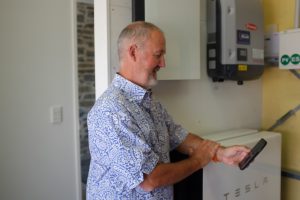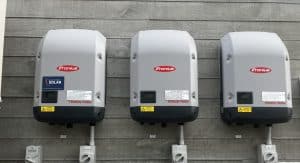What to look for in a solar inverter
What is a solar inverter?
The inverter is one of the most vital parts of your solar system. It converts DC power produced by your solar panels into AC electricity for your home.
Your inverter will work very hard for a long time, as it converts the sunlight that hits your roof into usable electricity. For this reason it’s important you choose a quality inverter that will power your appliances for years to come.
So, how can you choose a good inverter?
Here are some of the things you need to consider when matching with your perfect inverter.
Track record
European companies like Fronius and SMA have a proven track record. They are known in the solar world for producing the highest quality inverters. They had the luxury of learning from their mistakes in the early days and now have the most advanced, reliable technology of any solar inverters.
A quality inverter should keep going for 15-20 years.
You can expect an entry level inverter to struggle to make their warranty period without a replacement or two. Therefore the company still being around to honour it is pretty important!
Warranty
It’s easy to put out a cheap product served with a marathon warranty and hope for the best. That’s what seems to be happening at the moment with entry level solar inverters.
When looking at a warranty you need to look at the length of the warranty (they’re pretty much all the same), but more importantly how that company will actually deal with warranty issues.
Look at the company’s track record, reviews and of course any data on actual failure rates is handy. Better than a good warranty is not having to put through a claim in the first place.
Fronius aims for lower than a 0.5% failure rate. We can vouch for that as in the last 8 years we haven’t had a single Fronius inverter failure!
Support
Just like warranty, make sure you get your inverter from a manufacturer that actually offers the support they say they do. You may save yourself hours on hold. So be sure to surf the web for other peoples experiences.
As we’re in New Zealand, it’s worth checking that the particular manufacturer has NZ based support.
Of course we deal with any issues on your behalf, but local NZ support is much better if any issues arise. Fast turnarounds of replacement parts can get you back power producing in no time.
Maximum Power Point Trackers (MPPT)
Throughout the day, the sun’s intensity is constantly changing, a bird might perch on your panels or a cloud floats by causing some shade. Your inverter knows this and in order to get the most out of your solar panels in the changing conditions, your inverter has an MPPT aka a Tracker.
Trackers continuously re-assess what’s happening with your panels, then change the voltage to squeeze the most power out of them.
As you would expect, cheaper inverters have basic trackers (you will produce less energy) and quality inverters have good trackers (you will produce more energy).
Basic trackers can’t cope with shade very well. In fact a bit of shade on one panel using a basic tracker can bring all the panels production down to the single affected one. Meaning you produce less energy overall.
Get yourself a good tracker like the ones hidden inside Fronius inverters and you’ll have the piece of mind that the little bit of shade from a tree, pigeon or cloud on its way by, won’t affect the other panels on your roof.
Check out Fronius Dynamic peak manager for more on how a good tracker saves you more.
Monitoring
 You want to know what’s going on? Then you need some good monitoring.
You want to know what’s going on? Then you need some good monitoring.
Some monitoring systems can be hard to figure out (you guessed it, entry level inverters). Whereas we’ve found quality inverters come with much easier to understand platforms, allowing you to be an energy expert in no time.
You want to be able to see, in real time, how much power you are producing, as well as what your appliances are consuming. How else are you going to know if you have enough spare solar to put the washing machine on a hot wash.
Production and consumption data should be saved and viewable so you can look back at the past and see how you’ve done. At least then you know where to stear your energy use in the future. With this feedback you’ll be able to get more and more efficient as time goes by.
One of our favourite monitoring platforms is Fronius Solar.Web which allows you to view detailed information on your current energy use as well as detailed analysis over the entire life of your system.
Cooling
When you’re working hard you tend to get hot. If you can catch a breeze or cool down with a cold drink, then you can carry on your summer gardening. But if you can’t get any respite, your workload will drop off.
An inverter is no different. The electronics inside need to stay cool in order to stay efficient when turning your sunlight into electricity. If the inverter gets too hot, it will slack off and your energy production will drop.
Make sure your inverter has a decent cooling system. It seems to be fashionable on the cheaper end of inverters to get rid of the fan and whack a massive heatsink on the back of the inverter to dissipate the heat. The track record of keeping the electronics cool by doing this isn’t great. I think the main reason they do this is so they don’t have to repair the cheap fans when they break.
Good old active cooling, blowing a breeze over your circuit boards is the failsafe way to keep things cool. Of course a heat sink in conjunction with a fan is even better.
Fronius maintains that active cooling is the best way to keep the electronics cool and they have the track record to prove it.
Load control
Wouldn’t it be good if the data from your monitoring platform could be used to switch on appliances when you had spare solar without even thinking about it.
Well you actually can as long as your inverter has the correct bits, or is compatible with some 3rd party products. We love using quality products as they generally come with much more functionality.
For example, hot water, pool heating or pumps and EV’s can be controlled, so that they draw power when there is solar going spare.
This can be done either by your inverters controllable outputs, or by adding additional products like a smart EV charger or a Hot water diverter.
With Fronius inverters, we are able to control loads in your home to maximise the use of solar energy using the inbuilt I/O controls.
Or by linking the inverter with some other products like the Ohm Pilot (hot water diverter) and Watt Pilot (smart EV charger).
To Sum up
 Like most things, you get what you pay for. Expect to pay nearly twice the price for a top end inverter compared to an entry level brand. But at the same time expect to replace it half as much, have half the hassle and be twice as happy.
Like most things, you get what you pay for. Expect to pay nearly twice the price for a top end inverter compared to an entry level brand. But at the same time expect to replace it half as much, have half the hassle and be twice as happy.
Buy Quality. You won’t replace a quality inverter every few years, you’ll have much more run time and produce higher energy yields for the life of your solar investment.
Get one with good trackers that can handle the odd bit of shade. Let’s face it, it’s not always clear blue skies and birds will leave their mark. You need a tracker that is not going to give up and settle for low power outputs.
Make sure the warranties and support offerings are true and stand up. Don’t get sold down the apples for apples route, then you find out one of them is a lemon.
Get the monitoring system that will allow you to understand your system without the equivalent of needing to learn a new language.
Feel free to reach out to us if you want to learn more about inverters and any other solar related subjects.